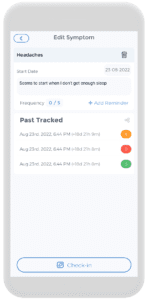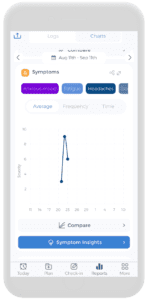
“Are my puffy eyes connected to my headaches or an indication of something else?”. This is likely a common question you ask yourself when trying to make sense of the symptoms that come along with your headaches. You are not alone in trying to understand why you may be experiencing swollen eyelids and a headache. There is quite an interesting association between swollen eyelids and headaches. Tracking these types of symptoms through the CareClinic platform can also help you understand your triggers and how to manage your symptoms more effectively.
Starting with a holistic overview of headaches. The important thing here is to understand how headaches develop and how swollen eyelids occur at a very basic level. According to research, a great percentage (approximately 70%) of people with headaches experience puffy eyelids. Although you may notice this physically distinct symptom when you look in the mirror, it is still relatively underreported. Why? Well, swollen eyelids are more commonly mistaken for being associated with allergies, flu, etc. Moreover, headaches do show some correlation with other flu-like symptoms.[1][2]
What Does Swollen Eyelid Mean?
Some people experience swollen eyelids as an associated symptom of a headache. Research suggests that it is an uncontrollable effect on our autonomic nervous system. Some other autonomic symptoms are fatigue in the eyes, a swollen face, drooping eyebrows, and red eyes. But what is the autonomic nervous system, and what does it do?
What is the Autonomic Nervous System?
This is the part of the nervous system that controls our involuntary body functions, such as heart rate, blood flow, breathing, sensation, etc. With migraine headaches, people often experience more severe autonomic symptoms such as dizziness, blurry vision, nausea, and digestive disturbances. An increase in blood flow to certain areas of the body causes symptoms of facial flushing, ear fullness, swollen eyelids, or nasal congestion.
How do Puffy Eyes Develop with Headaches?
If you’ve noticed that some of these symptoms seem similar to those of the common cold or flu, you would be one step ahead of the game! However, there is a main difference; the trigger here is your pain receptors rather than a viral illness. When someone gets a headache, the pain sensors, a vital part of the autonomic nervous system, get triggered. This initiates a response similar to that of the flu. Cue the puffy eyes, swollen eyelids, nasal congestion, and facial flushing. There are many more symptoms like these that are commonly associated with cluster headaches, followed by migraine headaches.[3]
What is a Headache?
So, what is a headache? A headache is a pain experienced in any part of the head, including the scalp, upper neck, face, and interior of the head. When they occur, they can range in severity from mild to debilitating. Additionally, headaches are divided into two main types:
Primary Headaches
These are the headaches that do not occur due to some other disease. Furthermore, they are the most common type of headache and one of the most common reasons people visit doctors for. There are 3 types of primary headaches:
- Tension-type headache: This is the most common type of headache in the general population. It is a band-like headache and is mostly mild to moderate in intensity. It does not present with distinctive features like puffy eyes, drooping eyebrows or eye fatigue.
- Cluster headache: This type of headache is less common (around 1%) and it belongs to a group of headaches that occur on autonomic factors involving a facial nerve (trigeminal nerve). This is a short-term pain that stays for about 30 minutes to one hour. The pain classically appears over the temple or around one of the eyes and is associated with flu-like symptoms such as puffy and droopy eyes, nasal congestion, and a flushed face.
- Migraine headache: This type of headache affects 12-15 % of the general population and is the main cause of neurologist visits among all types of headaches. Migraines are more common in females than males, and there is a genetic predisposition component. A migraine headache is typically a pulsating, and often debilitating, pain. It can be present on one or both sides of the head and is usually associated with specific triggers such as physical activity, light, smells, and sound. Nausea, vomiting, and sensitivity to light and sound are some of the associated features. Around 70% of individuals experiencing migraines also experience autonomic symptoms, including puffy eyes, heart rate disturbances, nausea, and blurry vision.
Headaches in the Morning
These headaches mainly occur are a result of another disease or illness, ranging from mild to severe. If you experience the following danger signs with your apparently benign headache, consult your doctor right away:
- Fever
- Neck stiffness
- Weakness, numbness, or loss of sensation in any part of the body
- Sudden or abrupt onset
- Older age
- Positional headache
- History of Cancer (anywhere in the body)
- Change in the usual pattern of headache
- History of immune deficiency (HIV, organ transplant recipient, etc.)
- Painkiller overuse
Most primary headaches are clinical diagnoses and do not require any investigations. Secondary headaches, however, warrant further testing, such as a CT scan of the head, a lumbar puncture (fluid removal from the spine for testing), blood tests, and some specific biopsies. The warning signs mentioned above should always be considered to rule out serious conditions as the cause of secondary headaches.
h2, h3 { display: inline-block; }
Managing Your Swollen Eyelids and Headache
There are 2 branches of management when it comes to swollen eyelids and headaches: pain management and managing your swelling.
Treating Swollen Eyelids
The following steps can be taken if you have developed puffy eyes as a result of a headache:
- Such as rinsing your eyes with water to remove any possible irritants in the eyes
- Placing a cold compress on your eyes
- For example, removing any foreign objects (contact lenses, etc) from your eyes
Treating Eye Swelling
Since puffy eyes are exhibited in response to pain triggers, controlling pain is an integral part of the management process. It is incredibly important to identify your triggers in order to stop the headaches in their tracks. One of the best ways to do this is by creating a headache diary to track your symptoms, pain levels, and environmental factors.
Symptom Tracking
Maintaining a headache diary is a time-proven method of identifying and avoiding triggers. It helps you figure out specific triggers and any changes in your headache patterns. A headache symptom tracker a key tool to identify if someone’s primary headache turns into a secondary headache due to a dangerous cause. The CareClinic platform allows you to track your headaches and maintain a diary by giving you an easy-to-use objective tracker feature. Moreover, all your data is saved conveniently on your phone and can be retrieved and reviewed by yourself or your healthcare provider.

- Such as the time and place where the headache began
- Location of headache (half of the head, entire head, or neck)
- Quality of the pain (throbbing, sharp, etc.)
- Change in intensity of the headache
- The environment where the headaches started
- Any changes in the routine
- Duration of pain symptoms
- Specific symptoms before the onset of the headache (changes in vision, changes in the sense of smell, difficulty speaking)
- Such as associated symptoms (puffy eyes, nausea, vomiting)
Pain Management
You may use the pain scale faces within the App when recording pain before taking any medication and after. There are many painkillers that people use to combat their headaches. They can range from over-the-counter medications for milder forms of headaches to more potent prescription medications with opioids.
Over-the-counter analgesics include:
- Non-steroidal anti-inflammatory drugs (Advil, ibuprofen, naproxen)
- Acetaminophen (Tylenol)
- Aspirin
- Caffeine combined with analgesics
Prescription Medications include:
- Such as Tylenol with codeine (Tylenol #3)
- Antidepressants (amitriptyline)
- Triptans (for migraine and cluster headache)
- Morphine (for special consideration only)
Management for Specific Types of Headaches
Puffy eyes are most commonly associated with cluster headaches. Some treatment options you may consider include:
Cluster Headaches
- Acute Therapy: This may include inhaling 100% oxygen for twenty minutes or triptan medications ( Sumatriptan, zolmitriptan) within thirty minutes. However, it is important to remember that these forms of intervention are only used in urgent scenarios.
- Transitional Treatment: Cluster headaches usually come in bouts and follow the same patterns. Once you have taken urgent management, there is still a chance the headache will come back as strong as ever. Some treatment options are effective if used in this transitional period, after which the preventive medication’s effect takes place. Some transitional treatments include:
- Steroid (prednisone) short-term pills are effective in controlling the symptoms
- Nerve block injections are a second-line option for patients either allergic to steroids or have contraindications for steroids
- An intranasal anesthetic medication (to control autonomic symptoms)
Preventive Treatment: The timing for preventive treatment starts at the onset of the initial headache. You should take these forms of treatment daily to prevent headaches from recurring. Additionally, unlike some other medications, if your symptoms ever return, you can be assured that starting treatment up again will come with no other unwanted side effects. It’s safe and a great option for treatment! The following medications are some tested and approved forms of preventative treatment:
- Verapamil – a type of medication called a calcium channel blocker
- CGRP (Calcitonin gene-related peptide antibodies)
Migraine Red Eyes
Specific migraine treatments are based on a combination of prophylactic management while avoiding migraine triggers identified through symptom tracking or a headache diary. Moreover, while migraines can be incredibly uncomfortable and painful, it is important to limit the use of medications you take when a headache sets in. In fact, taking too much medication can actually lead to another type of headache known as a medication-overuse headache.
Pharmacological Management: For migraine attacks and prophylaxis, beta-blockers (propranolol), antidepressants (Amitriptyline), and anti-seizure medications (valproic acid) are commonly used. These medications must be taken with your doctor’s advice and may come with their own corresponding side effects.
Non-pharmacological therapy: Many non-medical remedies and therapies can help in the management of a migraine. These modalities include:
- For example, avoidance of migraine triggers
- Behavioural therapy
- Physical therapy
- Acupuncture
- In addition to lifestyle changes
Tension Headaches
Most tension-type headaches are self-limiting and are easily resolved with over-the-counter medication. More natural remedies, such as behavioral and physical therapies are also beneficial when it comes to tension-type headaches. Some of these non-medicinal options include:
- Avoidance of triggers: Triggers or precipitating factors are changes that can stimulate a headache attack or make an existing episode get worse. According to a recent research study, around 75% of patients reported at least one trigger of an acute migraine episode. Some of the most commonly reported triggers include:
- Such as Emotional Stress
- Hormonal effect (in females)
- Hunger
- Weather changes
- Sleep disturbances
- Odors
- Neck pain
- Lights
- Alcohol
- Smoke
- Lack of sleep
- Heat
- Exercise
- Along with the sexual activity
Therapies To Consider
- Behavioral therapy: Headaches can be triggered or worsened by stress, anxiety, depression, and other psychological factors. Additionally, battling with constant or repeated headaches and associated facial symptoms, like swollen eyelids, can affect an individual’s relationship both personally and professionally. The purpose of behavioral therapy is to help you by addressing your stress, anxiety, depression, and any other psychological issues. In addition, it focuses on relaxation techniques, group psychotherapy, and cognitive behavioral therapy
- Physical therapy: Physical therapists with special interests in headache management can also be a great help when it comes to swollen eyelids and headaches. Physical therapy is an adjunct therapy with other remedies, such as medication. Some forms of physical therapy you may be doing already include stretching exercises, and cold and heat packs to help with the headache.
- Acupuncture: Acupuncture is a form of alternative medicine and a component of traditional Chinese Medicine. This technique involves inserting very fine needles into the skin at specific points over your body. Though it is not widely accepted scientifically, many individuals acknowledge and recommend its effectiveness in pain and stress management.
- Lifestyle changes: In addition to the above-mentioned remedies, making small adjustments to your life can make a huge difference in how you feel. These changes are known as lifestyle modifications that can slowly help you get rid of headaches once and for all. These include:
- Reducing alcohol intake
- Decreasing or avoiding caffeine
- Smoking cessation
- Relatively fixed meal timings
- Regular exercise
Note on Therapies

Figuring out what changes to make can be difficult. Fortunately, the diary function in the CareClinic platform helps you track your headaches with great detail, allowing you to discover trends and triggers you can easily change in your life. The diary function is a great way to track your headaches at a glance. You review and reflect on each headache and what seemed to help you manage them!
Please note: There are many herbal and homeopathic remedies advertised widely on the internet. However, their efficacy is not well-understood and scientific data does not support them to date. Make sure to always do your own research and use them with caution. It is always best practice to also discuss with your family physician about an individual remedy personalized to you. Remember to use our medication tracker, which will create a medication log for you to review how well your treatment is progressing.
Tracking your Swollen Eyelids and Headaches
To start, you can track your current symptoms, the last time you had an episode of headache, and whether or not you experienced swollen eyelids with it. Further, you can start tracking any more episodes of headaches by paying attention to possible triggers. This will help identify and create a relation between headaches and specific triggers so you can avoid them in the future. The platform allows you to be creative with your planning and include relevant people around you, like your medical team! In this way, the CareClinic platform helps you create a support group of your own to help you through the symptoms you are experiencing.
Symptom Tracker
The symptom tracker allows you to input any symptoms you are experiencing, may they be a headache or associated symptoms like puffy eyes, or flu-like symptoms. You can use this to track your symptoms and compare them with the previous episodes. Consequently, the platform helps create real-time data for review.
Diary Entry
With the diary entry feature, you can make entries about any specific headache episode and the external/environmental factors surrounding the episode. You can even enter about how you are feeling to determine if there is an emotional component to your headaches! The diary feature also allows you to add pictures to your entry. Moreover, you can upload pictures of your swollen eyelids and compare them with the intensity of the headache to determine if there is a correlation, all at just a glance! This data can then be shared with a healthcare provider from within the platform. CareClinic makes it easy to get an objective opinion from credible healthcare professionals.

Reports
This is an incredible feature that can be a source of awareness and understanding about your headache and associated autonomic symptoms like swollen eyes, facial redness, runny nose, etc. By accounting for the symptoms that you enter, the platform creates a comprehensive report that clearly shows any association and correlation with your symptoms. You can compare your symptoms with associated triggers and identify triggering or aggravating factors.
Reminders
The CareClinic platform allows you to set reminders to track your symptoms, medications, factors, and headaches at any time of your choosing! You can adjust the frequency of reminders, the days they occur, and what they are for all within the platform!
To summarize, struggling with a variety of headaches in itself is debilitating. When the physical symptoms come in association with the headaches, like puffy or droopy eyes, facial congestion, and runny nose, it can be an even more stressful situation. We have established that it is quite possible that your symptom of swollen eyelids is a result of your headaches.
If you are facing symptoms of headaches and notice some extra symptoms that come with the headache, we suggest consulting a doctor. However, going to the doctor in today’s busy world can sometimes be inconvenient and difficult. The CareClinic platform brings healthcare within your hands’ reach. Fortunately, CareClinic helps you stay aware of your symptoms and keep track of them. In this way, you are always the boss of your body and are in a better position to make the best choices for yourself.
References
- “Cluster headache: MedlinePlus Medical Encyclopedia”. https://medlineplus.gov/ency/article/000786.htm
- “Migraine Symptoms: Puffy Eyelids”. https://migraine.com/migraine-symptoms/puffy-eyelid
- “Cluster Headache Ptosis Causes & Relief – Acibadem Health Point – ACIBADEM Hospitals – Acibadem Health Group”. https://www.acibademhealthpoint.com/cluster-headache-ptosis-causes-relief/
- “Headache Overview – Harvard Health”. https://www.health.harvard.edu/a_to_z/headache-overview-a-to-z
- “Headache Diary and Monitoring Apps | National Headache Foundation”. https://headaches.org/resources/headache-diary-keeping-a-diary-can-help-your-doctor-help-you/
- “Don’t recommend prolonged or frequent use of over-the-counter (OTC) pain medications for headache. | AAFP”. https://www.aafp.org/pubs/afp/collections/choosing-wisely/161.html
- “European Academy of Neurology guidelines on the treatment of cluster headache – May – 2023 – European Journal of Neurology – Wiley Online Library”. https://onlinelibrary.wiley.com/doi/full/10.1111/ene.15956


